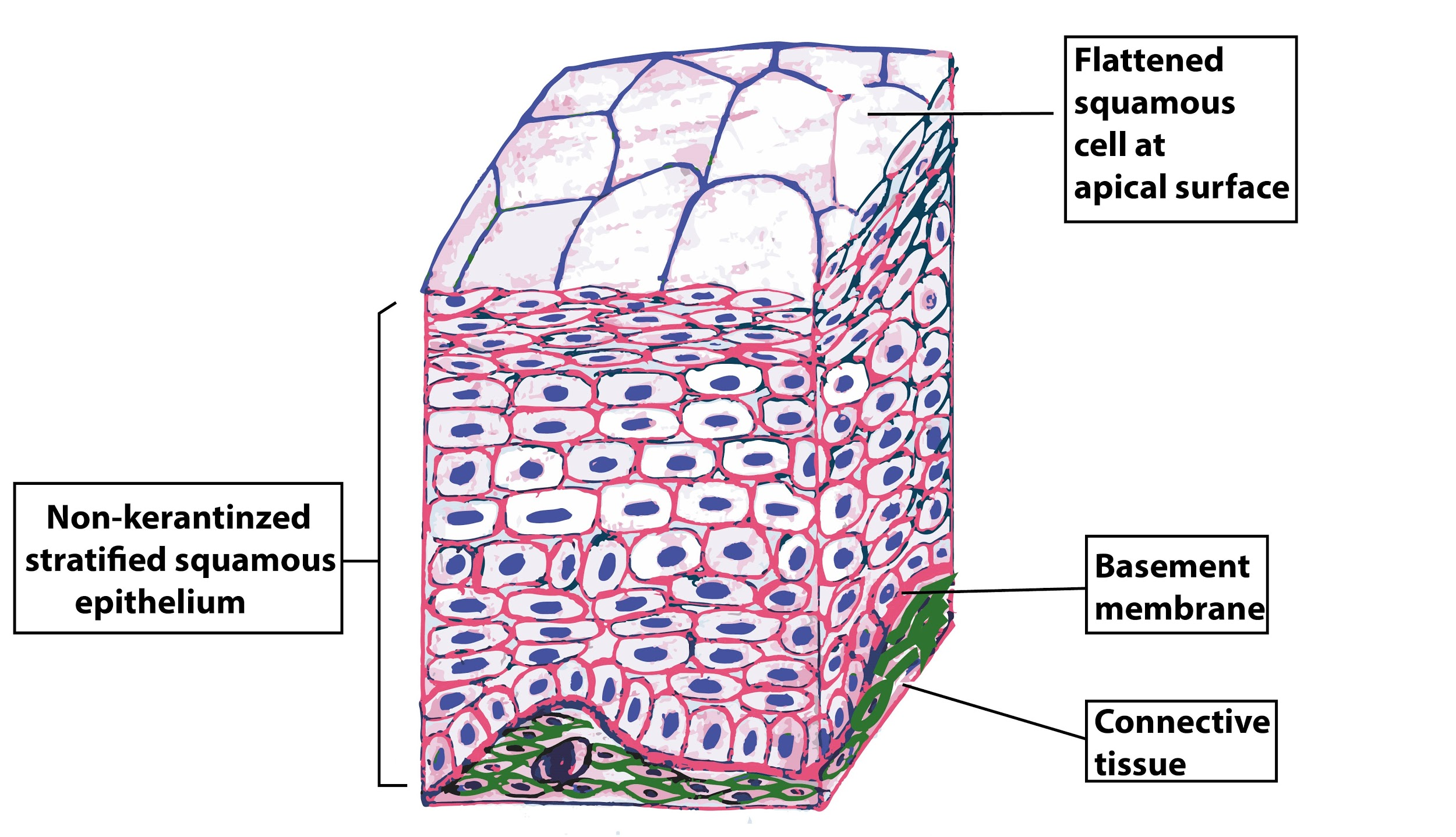
Non-keratinised stratified squamous epithelium is found in
(a)Skin
(b)Stomach
(c)Oesophagus
(d)Intestine
Answer
493.2k+ views
Hint: The organ is a tube-like structure lying between the mouth and stomach and serves as a passage for the food from the mouth to the stomach. Its upper part lies just behind the trachea or windpipe.
Complete answer:
Non-keratinized epithelium usually secretes mucus as an additional protective and lubricating layer. A non-keratinized stratified squamous epithelium consists of cells arranged in layers upon a basal membrane. It is found in the esophagus of human beings. The esophagus is also known as a food pipe, so it needs continuous lubrication for the passage of food particles. Hence, a non-keratinized tissue is required for the production of mucus and lubrication of the esophagus.
This squamous (flat) epithelium forms the outermost layer of the inner lining of the mouth, esophagus, and vagina. Non-keratinized surfaces are kept moist by bodily secretions to prevent them from drying out. Examples of non-keratinized stratified squamous epithelium include the cornea, lining mucosa of the oral cavity, esophagus, anal canal, vagina, and the internal portion of the lips.
Additional Information: -Stratified squamous epithelia are the tissues formed from multiple layers of cells resting on a basement membrane, with the superficial layer(s) consisting of squamous cells.
-The underlying cell of the stratified squamous epithelial layers can be made of cuboidal or columnar cells as well.
-The basal layer is attached to the basement membrane, contains a sheet of extracellular matrix proteins, and is crucial in the self-renewal process.

So, the correct answer is, ’Oesophagus.’
Note: In the case of the non-keratinized stratified squamous epithelium, only one layer is in contact with the basement membrane and the other layers are adhered to one another to maintain structural integrity. Additionally, the layer can be sequentially sloughed (removed) off and replaced before the basement membrane is exposed.
Complete answer:
Non-keratinized epithelium usually secretes mucus as an additional protective and lubricating layer. A non-keratinized stratified squamous epithelium consists of cells arranged in layers upon a basal membrane. It is found in the esophagus of human beings. The esophagus is also known as a food pipe, so it needs continuous lubrication for the passage of food particles. Hence, a non-keratinized tissue is required for the production of mucus and lubrication of the esophagus.
This squamous (flat) epithelium forms the outermost layer of the inner lining of the mouth, esophagus, and vagina. Non-keratinized surfaces are kept moist by bodily secretions to prevent them from drying out. Examples of non-keratinized stratified squamous epithelium include the cornea, lining mucosa of the oral cavity, esophagus, anal canal, vagina, and the internal portion of the lips.
Additional Information: -Stratified squamous epithelia are the tissues formed from multiple layers of cells resting on a basement membrane, with the superficial layer(s) consisting of squamous cells.
-The underlying cell of the stratified squamous epithelial layers can be made of cuboidal or columnar cells as well.
-The basal layer is attached to the basement membrane, contains a sheet of extracellular matrix proteins, and is crucial in the self-renewal process.

So, the correct answer is, ’Oesophagus.’
Note: In the case of the non-keratinized stratified squamous epithelium, only one layer is in contact with the basement membrane and the other layers are adhered to one another to maintain structural integrity. Additionally, the layer can be sequentially sloughed (removed) off and replaced before the basement membrane is exposed.
Recently Updated Pages
The correct geometry and hybridization for XeF4 are class 11 chemistry CBSE

Water softening by Clarks process uses ACalcium bicarbonate class 11 chemistry CBSE

With reference to graphite and diamond which of the class 11 chemistry CBSE

A certain household has consumed 250 units of energy class 11 physics CBSE

The lightest metal known is A beryllium B lithium C class 11 chemistry CBSE

What is the formula mass of the iodine molecule class 11 chemistry CBSE

Trending doubts
State the laws of reflection of light

One Metric ton is equal to kg A 10000 B 1000 C 100 class 11 physics CBSE

Difference Between Prokaryotic Cells and Eukaryotic Cells

What is the modal class for the following table given class 11 maths CBSE

How do I convert ms to kmh Give an example class 11 physics CBSE

Give an example of a solid solution in which the solute class 11 chemistry CBSE




